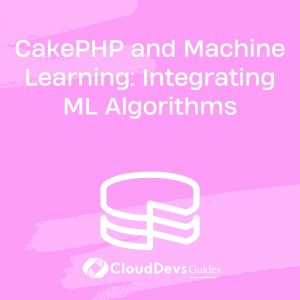CakePHP and Machine Learning: Integrating ML Algorithms
In the fast-paced digital world, where data drives decisions, the integration of machine learning (ML) algorithms into web applications has become a game-changer. CakePHP, a popular PHP framework, provides a solid foundation for building dynamic web applications quickly. Imagine the potential when CakePHP’s flexibility is combined with the predictive power of machine learning. In this article, we’ll delve into the exciting realm of integrating ML algorithms into CakePHP applications, unlocking new possibilities and functionalities.
Table of Contents
1. Understanding CakePHP and Its Power
Before we dive into the world of machine learning, let’s briefly understand CakePHP and what makes it a preferred choice among developers.
1.1. What is CakePHP?
CakePHP is an open-source PHP web framework that follows the Model-View-Controller (MVC) architectural pattern. Its main goal is to make web development faster and easier, while also promoting code reusability and maintainability. With features like scaffolding, ORM (Object-Relational Mapping), and built-in security mechanisms, CakePHP provides a structured and streamlined way to build web applications.
1.2. Benefits of CakePHP:
- Rapid Development: CakePHP’s convention over configuration approach speeds up development by reducing the need for repetitive coding.
- Built-in Tools: Features like database ORM, form handling, and security components save time and effort during development.
- Security: CakePHP incorporates built-in security measures like data validation, SQL injection prevention, and cross-site scripting (XSS) protection.
- Community and Documentation: A strong community and comprehensive documentation ensure that developers can easily find support and resources.
2. The Fusion: CakePHP Meets Machine Learning
Machine learning has revolutionized the way we interact with data and make decisions. By integrating ML algorithms into CakePHP applications, we can add a layer of intelligence and automation that enhances user experiences and provides valuable insights. Let’s explore how this fusion can be achieved.
Step 1: Data Collection and Preparation
Machine learning thrives on data. The first step is to identify the data points that can be used for training and prediction. In a CakePHP application, this data can come from various sources, such as user interactions, product preferences, or historical data.
Code Sample: Data Collection in CakePHP
php
// Controller action to collect user interactions
public function collectUserInteractions() {
$interactionData = $this->request->getData();
// Process and store the data
}
Once the data is collected, it needs to be cleaned, transformed, and preprocessed to make it suitable for ML algorithms.
Step 2: Choosing the Right ML Algorithm
The choice of ML algorithm depends on the nature of the problem you’re trying to solve. Regression for predicting numerical values, classification for categorizing data, and clustering for grouping similar data are common tasks.
Code Sample: Using Linear Regression (Scikit-Learn) in CakePHP
php // Assuming data is already prepared $features = [[2.5], [3.2], [1.8], [4.5]]; // Input features (e.g., user ratings) $labels = [150, 180, 120, 210]; // Corresponding labels (e.g., product prices) // Using Scikit-Learn library for linear regression from sklearn.linear_model import LinearRegression model = LinearRegression() model.fit(features, labels) // Predicting the price for a new user rating $newRating = [[2.8]]; $predictedPrice = model.predict(newRating);
Step 3: Integration with CakePHP
Integrating ML algorithms seamlessly into CakePHP requires creating a bridge between the two. This can be achieved through custom components or helper classes that encapsulate ML functionality.
Code Sample: Creating a Machine Learning Component
php
// MachineLearningComponent.php
class MachineLearningComponent extends Component {
public function predictUserBehavior($data) {
// Use a pre-trained ML model to predict user behavior
// Return predictions
}
}
Step 4: Enhancing User Experiences
With ML algorithms integrated into CakePHP, you can now enhance user experiences by providing personalized recommendations, intelligent search suggestions, or behavior-based notifications.
Code Sample: Personalized Recommendations
php
// Using the MachineLearningComponent to provide recommendations
$this->loadComponent('MachineLearning');
$userInteractions = $this->getUserInteractions($userId);
$predictedPreferences = $this->MachineLearning->predictUserBehavior($userInteractions);
// Use predicted preferences to recommend relevant products
3. Potential Use Cases
The integration of machine learning with CakePHP opens doors to numerous use cases across various industries.
3.1. E-Commerce: Personalized Product Recommendations
E-commerce platforms can leverage ML algorithms to analyze user browsing and purchase history to offer personalized product recommendations. This enhances user engagement and increases the likelihood of conversions.
3.2. Healthcare: Disease Prediction
ML algorithms can analyze patient data to predict the likelihood of certain diseases or conditions. CakePHP can facilitate data collection from various sources, while the ML algorithms provide insights to healthcare professionals.
3.3. Finance: Fraud Detection
By integrating ML algorithms into CakePHP-based banking applications, financial institutions can detect potentially fraudulent transactions based on patterns and anomalies in transaction data.
3.4. Entertainment: Content Recommendations
Streaming platforms can use ML algorithms to analyze user preferences and viewing history, enabling accurate content recommendations and a more personalized user experience.
4. Challenges and Considerations
While the integration of ML algorithms with CakePHP opens up exciting possibilities, it’s essential to be aware of certain challenges and considerations.
4.1. Data Quality and Privacy
ML algorithms heavily rely on data quality. Dirty or biased data can lead to inaccurate predictions. Moreover, handling sensitive user data requires robust privacy measures to ensure compliance with regulations.
4.2. Model Maintenance
ML models aren’t static; they require periodic updates to remain accurate and relevant. Ensuring smooth model updates without disrupting the application’s functionality is crucial.
4.3. Performance
ML algorithms can be resource-intensive. Optimizing the integration to maintain application performance is essential, especially during prediction and training phases.
Conclusion
The fusion of CakePHP and machine learning brings forth a new era of web application development. By combining CakePHP’s efficiency with the predictive power of ML algorithms, developers can create intelligent, data-driven applications that cater to user preferences and behavior. Whether it’s personalized recommendations, predictive analytics, or automation, the integration of machine learning adds a layer of sophistication that can revolutionize user experiences across various domains. As technology continues to advance, mastering the art of integrating ML algorithms with CakePHP can give developers a competitive edge in delivering innovative and impactful solutions.
Table of Contents








